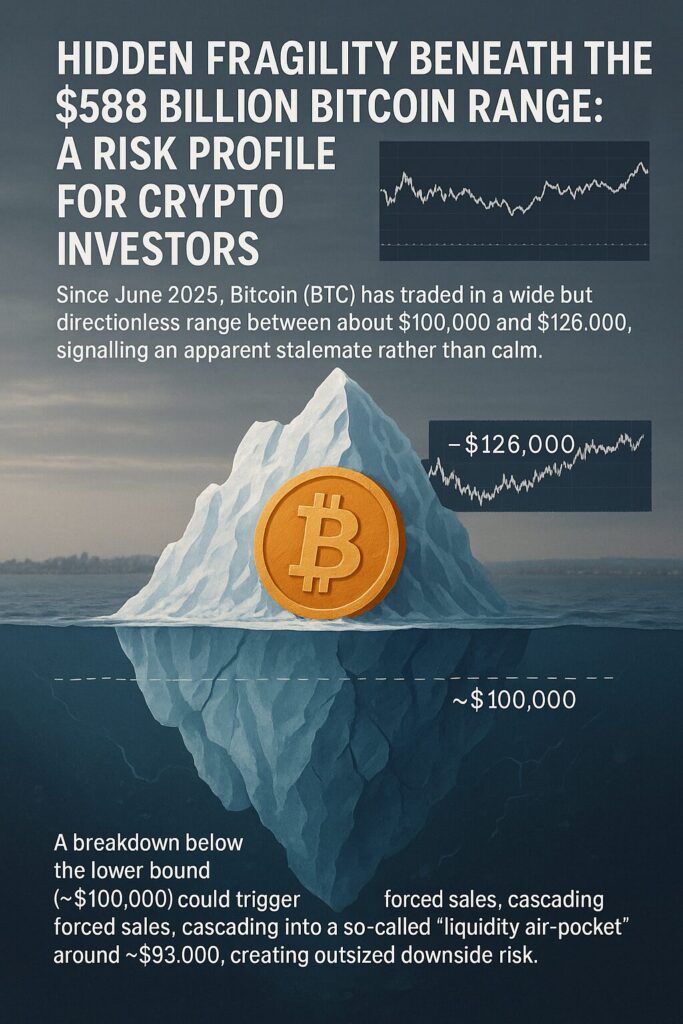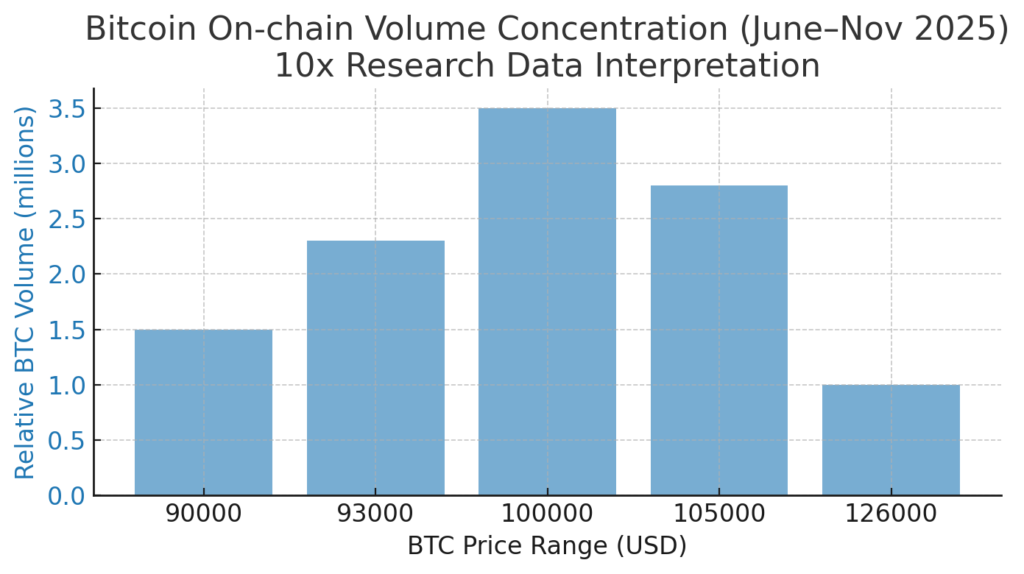
Key Points :
- Since June 2025, Bitcoin (BTC) has traded in a wide but directionless range between about $100,000 and $126,000, signalling an apparent stalemate rather than calm.
- On-chain data from 10x Research indicates that around 5.9 million BTC—equivalent to roughly $58.8 billion—moved within that range recently, a volume greater than the market cap of Ethereum (ETH).
- Much of this volume is now held by weaker hands: clients lacking conviction, corporate hedgers, risk-management desks, or sceptical institutions that may capitulate under price pressure.
- A breakdown below the lower bound (~$100,000) could trigger forced sales, cascading into a so-called “liquidity air-pocket” around ~$93,000, creating outsized downside risk.
- For new-asset seekers and blockchain practitioners, the implication is that while the range might look stable, embedded micro-instabilities often precede large shifts — meaning opportunities and risks coexist beneath the surface.
1. The Range Looks Calm—but Don’t Be Fooled
Since June 2025, Bitcoin has maintained a trading range roughly between $100,000 and $126,000. On the surface, this appears to be a period of consolidation or even stagnation. However, according to 10x Research, nearly 5.9 million BTC (≈ $58.8 billion) have moved within that range in recent months.
That figure alone dwarfs Ethereum’s market cap (~$42.8 billion reported in the referenced article).
For an investor or builder looking at crypto assets, the key takeaway is that “quiet consolidation” is often a misnomer—significant flows and reallocation continue even when price action looks muted.
2. Who is Moving the Coins? Weak Hands Dominate
Markus Thielen, founder of 10x Research, points out that “a lot of these coins now sit in the hands of investors with little conviction, institutional risk desks or sceptical corporate treasuries.”
The risk here: if price drops, these holders may not hold firm. Their balance-sheets may not be fragile because of leverage per se, but because the institutional appetite is lukewarm and risk-management triggers may force exits.
For someone scouting new crypto plays or building blockchain applications, this is a caution: the structural stability of the base asset (BTC) may be weaker than it appears.
3. The $93,000 “Air-Pocket” Danger Zone

Thielen highlights that if BTC loses the ~$100,000 level, a sharp descent might follow towards ~$93,000, where buying demand is relatively thin—a so‐called “liquidity air‐pocket.”
Further complicating matters: Eleven spot Bitcoin ETFs’ average acquisition cost lies near ~$90,000. Thus, a slide under ~$93,000 could force significant selling pressure from ETF structures doing mark-to-market or investor redemptions.
For builders, this matters: many blockchain use-cases peg their risk assumptions to BTC as a value anchor. If that anchor is vulnerable, downstream protocols reliant on stable collateral or oracle feed integrity may face higher systemic risk than anticipated.
4. Implication for New Crypto Assets: Opportunity and Threat
For investors looking for “the next big crypto asset,” the environment is double-edged:
- Opportunity: A fragile base asset means multi-asset portfolios could find asymmetric upside if they position right and the weak base cracks open new trends (e.g., altcoins, DeFi primitives, infrastructure tokens).
- Threat: If BTC drops into the air-pocket and drags altcoins, many new assets (especially low liquidity) might suffer disproportionate downside.
From an application-builder standpoint, if you are architecting systems that depend on Bitcoin’s stability (e.g., cross-chain settlement, stablecoin pegging, collateral networks), you should assume that the worst-case scenario is not a slow drift down but a sharp dislocation into the ~$90k zone.
5. Recent Trends & Broader Context
While the article focuses on cancerous range dynamics in Bitcoin, ancillary trends amplify the narrative:
- A recent report indicated retail investors have lost ~$17 billion as “Bitcoin treasury stocks” collapsed, suggesting broader market fragility among small investors.
- Research from K33 and others shows that during periods of stagnation or shallow volatility, derivatives flows (open interest, skew) offer earlier signals of impending directional moves.
- The macro environment remains uncertain: with Bitcoin’s price anchored near $100k, altcoins remain under pressure, institutional rotation is cautious, and regulatory variables continue to loom large.
For those building or investing, that means timing matters: the “calm before the storm” pattern often plays out in crypto.
6. Practical Strategies for the Audience
Given the above, here are strategic considerations:
- Portfolio diversification: Don’t assume BTC is a safe haven. If you believe crypto infrastructure or alternative chains will outperform, allocate accordingly—but retain risk buffers for a BTC drop.
- Liquidity focus: New crypto assets or tokens you back should have good liquidity and governance structures that can withstand market stress.
- Risk-management baked-in: In your smart contract systems, stress-test scenarios where BTC falls into that $90k zone. How does your protocol behave? Are oracle feeds still resilient? Does collateralization hold?
- Entry discipline: If you’re scouting altcoins, using a range-break in BTC as a trigger may enable high-conviction entries. Conversely, avoid crowd congestion near the high end of range until directional clarity emerges.
- Monitor on-chain flows: The internal movement of major coins—especially by institutions—is a stronger warning sign than simply spot price behaviour. The 5.9 M BTC movement is a textbook case.
7. Conclusion
While Bitcoin currently appears to be in a large but uneventful range (~$100,000–$126,000), beneath the surface lie sizable flows and structural vulnerabilities. The fact that nearly $58.8 billion of BTC has moved during this so-called “range” signals that the market is far from inert.
Importantly, much of that volume is now controlled by holders who may be predisposed to sell if the lower end of the range fails. The identified “air-pocket” around ~$93,000 represents a meaningful risk for a sharp drop.
For crypto-savvy investors and practitioners—those searching for the next asset or building real-world blockchain applications—the takeaway is critical: Range = Risk. A stable price band may lull you into complacency; the real work is architecture that assumes structural shifts, not range continuation.
In short: If you view Bitcoin as a bedrock, ask whether that bedrock is solid or brittle. If you’re chasing new assets or building ecosystems, now might be the time to position—but with your eyes wide open and your stress-tests rigorous.

